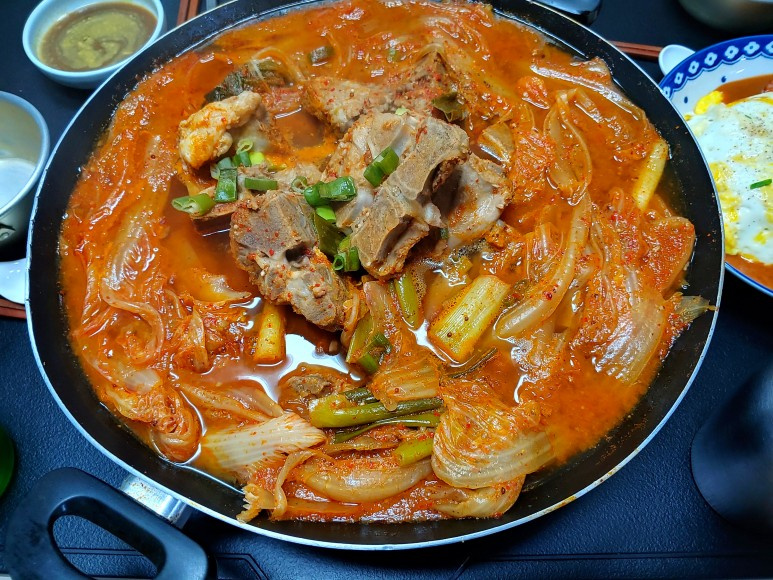Spicy and Refreshing Aged Kimchi Pork Back-Bone Stew (Muk-eunji Gamjatang)
How to Make Muk-eunji Gamjatang at Home That’s Even Better Than Store-Bought

Introducing Muk-eunji Gamjatang, the perfect dish for a rainy day, best enjoyed with a shot of soju. This recipe reveals the secret to tenderizing pork back-bones without a pressure cooker and crafting a deep, rich broth that rivals professional restaurants. Enjoy a taste of gourmet gamjatang right in your own kitchen!
Main Ingredients- 2kg Pork back-bone or neck bones
- 1/2 head of well-fermented aged kimchi (approx. 1kg)
- 1/2 cup soju (100ml)
- 3 bay leaves
Broth Seasoning Ingredients- 70g onion (approx. 1/4)
- 150g radish (approx. 1/6)
- 4 Korean green chilies (cheongyang peppers)
- 3 Tbsp gochugaru (Korean chili flakes) (30g)
- 75g doenjang (fermented soybean paste) (approx. 1/2 cup)
- 3 Tbsp salted shrimp juice (45ml)
- 2 Tbsp perilla seed powder (20g)
- 1 Tbsp sesame oil or perilla oil (15ml)
- 3 Tbsp coarse gochugaru (Korean chili flakes) (30g)
- 200ml water
Dipping Sauce (Optional)- 3 Tbsp soy sauce (45ml)
- 3 Tbsp water (45ml)
- 1 Tbsp corn syrup or rice syrup (15ml)
- 1 Tbsp mustard powder or paste (15g)
- 70g onion (approx. 1/4)
- 150g radish (approx. 1/6)
- 4 Korean green chilies (cheongyang peppers)
- 3 Tbsp gochugaru (Korean chili flakes) (30g)
- 75g doenjang (fermented soybean paste) (approx. 1/2 cup)
- 3 Tbsp salted shrimp juice (45ml)
- 2 Tbsp perilla seed powder (20g)
- 1 Tbsp sesame oil or perilla oil (15ml)
- 3 Tbsp coarse gochugaru (Korean chili flakes) (30g)
- 200ml water
Dipping Sauce (Optional)- 3 Tbsp soy sauce (45ml)
- 3 Tbsp water (45ml)
- 1 Tbsp corn syrup or rice syrup (15ml)
- 1 Tbsp mustard powder or paste (15g)
Cooking Instructions
Step 1
First, prepare 2kg of pork back-bones or neck bones. Place the bones in a large bowl and cover with cold water. Let them soak for 1 to 2 hours to remove any blood. It’s helpful to change the water once or twice during this process.

Step 2
Drain the bones and place them in a pot. Add fresh water to cover the bones, then add 1/2 cup (100ml) of soju and 3 bay leaves. Optionally, add a small piece of dried ginger to help remove any gamey smell. Bring to a boil over high heat, and once it starts boiling, continue to cook for about 10 minutes for the first boil.

Step 3
After the initial boiling, drain the bones and rinse them thoroughly under cold running water. Focus on removing any residual blood clots or small bone fragments. You don’t need to scrub them aggressively.

Step 4
Return the cleaned bones to the pot and add 2L of fresh water. Stir in a generous tablespoon of doenjang (fermented soybean paste). Doenjang helps to neutralize any remaining odor from the bones and adds a rich, savory depth to the broth. Begin simmering the bones in this broth.

Step 5
While the bones are simmering, let’s prepare the ingredients for the flavorful broth. Cut about 150g of radish into bite-sized pieces. Chop 70g of onion (about 1/4 of an onion) and 4 Korean green chilies (stems removed) into large chunks, making them easier to blend.

Step 6
Place the chopped radish, onion, and green chilies into a blender. Add 200ml of water and 3 Tbsp (30g) of gochugaru. Blend until smooth. This pre-blended paste will ensure the seasonings distribute evenly throughout the soup.

Step 7
As the bones simmer with the doenjang, you’ll notice a cloudy, whitish foam and impurities rising to the surface. This is a natural part of the process where impurities are removed from the bones.

Step 8
It’s recommended to skim off the initial foam as cleanly as possible. This helps to achieve a clearer broth and further reduces any unwanted odors. While this step is optional, it significantly contributes to a cleaner tasting soup.

Step 9
Now, it’s time to infuse the broth with the main flavors. Add the blended paste from the blender to the pot. Stir in an additional 3 Tbsp (30g) of coarse gochugaru and 3 Tbsp (45ml) of salted shrimp juice. Salted shrimp juice adds a fantastic umami boost. Let this mixture simmer over medium heat for about 20 minutes.

Step 10
Meanwhile, take half a head of aged kimchi (about 1kg). Rinse off the excess seasoning under running water. Then, tear the kimchi into long, bite-sized pieces. The tangy flavor of the aged kimchi will beautifully complement the gamjatang.

Step 11
After simmering the bones for 20 minutes, add the prepared kimchi to the pot. Continue to cook for another 20 minutes, allowing the kimchi to soften and meld its flavors with the broth. Taste the soup. If it needs more depth, now is the time to add 2 Tbsp (20g) of perilla seed powder and 1 Tbsp (15ml) of sesame oil or perilla oil. Stir well. You’ll notice how these ingredients bring all the flavors together beautifully. Finally, adjust the seasoning with a little more salted shrimp or salt, if needed, to achieve your perfect taste.

Step 12
For the best experience, transfer the finished gamjatang to a wide, shallow pot (like a Korean hot pot or ‘jeongol’ pot) to cook and serve at the table. Arrange the pork bones attractively in the center and surround them with the torn kimchi. This presentation makes it easy to scoop out both the meat and kimchi.

Step 13
If you’d like a dipping sauce for the meat, you can easily make one. Simply combine 3 Tbsp (45ml) soy sauce, 3 Tbsp (45ml) water, 1 Tbsp (15ml) corn syrup, and 1 Tbsp (15g) mustard powder or paste in a small bowl. Whisk until well combined.



